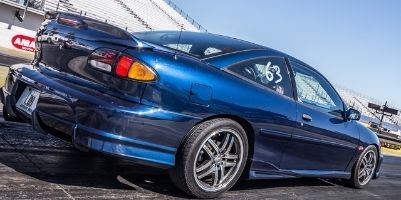cat and resanator delete, HP loss? - Performance Forum
Forum Post / Reply
You must log in before you can post or reply to messages.
I had a head GM mechanic tell me that if I straight piped my cat and res with a magnaflow muffler that I would lose horsepower? he said the comp needs a certain amout of back pressure, and I would lose HP by just even putting on a "fart can" muffler as he would put it..lol.. now he is a old school race guy who hates 4cyls.. but is this true? will I lose HP without a tune? he even is trainer to teach new guys and gals to learn the computer codes on all gm cars
my car is a 03 Z24 LS, I don't want to lose HP, plus its fun putting all this junk on our little cars!
has anybody dyno'd stock vs bolt ons with no tune?
thanks for your input on this
I doubt you would loose power. The more air you can get to flow into the engine and the more you can get out, the more power you should make. As long as there are no other bottlenecks, intake, heads, header, you should make more power.
My 89 z24 is straight piped with a 3in exhaust but that is a v6. No mufflers or cat.

On the inside my car looks like a fighter jet.
Wait a minute... a GM Head-Mechanic said what I only guessed about in terms of EGOS operation & back-pressure, for the sake of low-RPM fuel-consumption? Oh, Sparky's gonna need to hear about this! But anyway: Yes, even small changes... especially ones that will actually have a negative effect, like a "fart-can" muffler... will have an effect, and will require tuning for what the system cannot compensate for with it's existing fuel & spark mapping.
Go beyond the "bolt-on".
back pressure is the wrong terminology...
Velocity is the word everyone is looking for...
No cat + no resinator + (loud obnoxious garbage) magnaflow muffler is going to sound horrible. and unless you have cams/boost/p&p head/etc... and a good header, you will not see more than 5 whp if any at all...
Build your motor... then do your exhaust...
Basically, if you go to big on your piping... or you run really small piping and then you terminate it with a wide open muffler on a stock engine, you decrease the velocity of the exhaust gasses leaving the vehicle... when you decrease the velocity, you lose power... However if you go too small on piping, you iose flow...

^Good to see someone who follows the same applied-theory as I do... And that's to build the system for the power the engine produces, not to produce power. And that includes even for simple mods, like a header... Things that actually increase the flow of gases in & out of the engine.
And Mystic is right: The term, in the case of the oxygen sensor, is velocity... Contained, controlled velocity that allows the EGOS to actually read the exhaust's oxygen content accurately. But maintaining velocity throughout the system, all the way to the tailpipe, with minimal back-pressure is critical. Thankfully, someone whom has much-more time & money to do research into what an ideal (Rule-of-thumb) pipe size or muffler flow-rating for any amount of power produced has come up with an answer. And it's this:
2.2cubic-feet per-minute@10.5"-hg. for every 1hp produced.
Go beyond the "bolt-on".
^Was that difficult to follow? It goes like this: Carbs (Yes, they apply here!) are sized based upon the amount of air they flow under a vacuum-drop of 10.5" of mercury. Because this method is what id gone by when choosing a carb for an engine build, It's only safe to assume that since the engine's overall breathing [once blueprinted] is effected by what-all can flow in, and that being able to flow less than the ideal amount will hinder it (and vice-versa), then the vacuum-drop/flow-rating method should also be applied when choosing pieces for an exhaust system that's intended to work with an engine of any manner of build. But again, velocity is key... and we don't want the gases to flow like traffic on a one-lane road (too-small) or a tollway during rush-hour! (Too-big!)
For it too work properly, it must flow a specific amount to truly work efficiently. And that amount, under the vacuum-drop we're going by (as a rule), is 2.2cubic-feet per minute.
I know this seems difficult to follow... or apply to the parts intended for use in-question... but the research has been done (extensively) and these are the rules. Besides... There's a charts out there that give the flow-rating of various size pipes, and one that permits conversion of a flow-rating under one rate of drop to another. Plus, any muffler made that's worth it's metal has a flow-rating for the given pipe-size it's matched to listed on the box it comes in.
Go beyond the "bolt-on".
The ecu needs nothing in regards to back pressure.
 FU Tuning
FU Tuning
wow. fantastic info here!! thanks so much!!!!!!!!!!!!!!!
Rather than "back pressure," the mechanic is referring to "Scavenging." Scavenging is the process of pushing exhausted gas-charge out of the cylinder and drawing in a fresh draught of air ready for the next cycle. This process is essential to having a smooth-running engine. Modifying the exhaust system, (i.e. modifying the exhaust gas velocity by changing exhaust tube diameters) can detract from the "ideal" scavenging effects, and reduce fuel efficiency and power if not properly planned out and executed. To increase scavenging potential, the entire path from intake to exhaust to tailpipe must be tuned in sync with each other. This will ensure that the air flow is never interrupted. The acceleration and deceleration of this exhaust gas is what will hinder the scavenging potential. So, you don't want a bigger pipe to smaller pipe or smaller pipe to bigger pipe.

"In Oldskool we trust"
before I find a tunner that s close to me, I wanted to do the usual header/straight pipe/ to some kind of performance muffler, and I wanted to do either 2 1/4, or 2 1/2 in piping.. is it worth my while to buy a manderal system?
sure I'd love to build up a motor but I'm way to busy with school full time, so that will have to wait for now
Why bother with the straight pipe? Most high flow cats being made now are so effective that any losses are minimal, plus they help tone down the exhaust rasp and if you remove the cat without replacing it, you could be in for a hefty fine.

Craig Daye wrote:Is it worth my while to buy a mandrel system?
Yes,
always! And Y3llowCav is correct too... I just left that part about scavenging out for the sake of trying not to 'jack the thread and/or making it into a whole article about exhaust-system design & tuning. (Re: The work of David Vizard published in Popular Hot-Rodding)
Go beyond the "bolt-on".
great advice!! on to the illegal exhaust and then the tune!!!! free cheers for raspy mufflers
i went with 2.25" piping replaced my cat with a resonator that my local muffler shop sells and a custom y pipe in the back and it has a quiet deep sound not raspy at all felt a difference that helped me out alot and looked pretty good too
and i took off the rear o2 sensor and reset the computer (so my af ratio wouldnt go all crazy)
^^Rear o2 wont do anything in regards to your afr.
Unless you did something to get the rear o2 out of the stream youll be setting a code again asap without a cat.

if you're happy, we are happy.

"In Oldskool we trust"
well i felt the car running alot better when this was done and i later got tuned so the CEL when away
but thats just me
Something else people often overlook: the ideal exhaust flow rate varies by RPM. At slower engine speeds, less air volume is moving, so a smaller pipe provides an optimal velocity.
For a stock street car, the pipe size, dimensions, etc are tuned for efficiency, sound, and likely to provide optimal flow rate at the engine speed they think the car will spend most of its time (or where they think it needs a boost)--probably at highway speeds at 3-4k RPM. It helps get their highway MPG numbers lower, and makes the driver feel like he has more "passing power".
However, a race car will spend most of its life at high RPM, high output, and so needs a larger high flowing exhaust. For a smaller engine like ours, the effect of changing to a larger exhaust is noticable as a loss of low end power, but gains at mid-high.
So don't think of "upgrading" your exhaust as necessarily giving you more power, but as moving your power band to where it is more optimal for your intended driving style or use. Or if you've seriously upgraded the engine flow and you need to match the exhaust to it just to catch up and let it breathe better.
Air intake sizing is very similar in effect. Smaller tubing is more effecient for low end power, a wide open intake is better for wide-open throttle conditions.
I guess the point is... think about how you drive, and exactly how much engine modification you intend to accomplish while deciding on the exhaust. Bigger is not always better.
Well-put, man... That is a point that should be considered first & foremost. After that, everything else we've mentioned here just falls in-line behind it accordingly.
Go beyond the "bolt-on".
Forum Post / Reply
You must log in before you can post or reply to messages.




